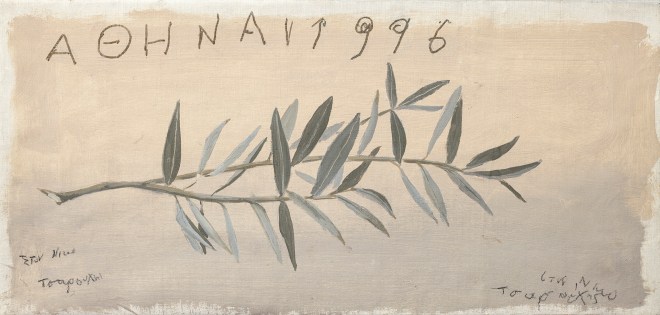A strikingly austere and quietly monumental work, Athens is Tsarouchis’ late-career homage to Greece’s classical past and modern aspirations. Executed in a palette of mooted beige and dusty olive green, the painting depicts a single wild olive branch — the kotinos — once used to crown victors at the ancient Olympic Games. With its bold simplicity and symbolic weight, the composition embodies the artist’s lifelong fusion of tradition and modernity.
The painting was originally conceived in the late 1980s, when Athens was bidding to host the 1996 Summer Olympics. At the request of the iconic Minister of Culture Melina Merkouri, Tsarouchis was invited to design a logo for the city’s candidacy. With characteristic decisiveness, he offered this image of the olive branch — a gesture rich in symbolism, echoing not only the ancient Games but also ideals of peace, humanism, and national pride.
A leading figure of 20th-century Greek art, Tsarouchis forged a unique visual language that bridged classical antiquity, Byzantine iconography, folk art, and European modernism. His style was shaped by formative encounters with the work of Matisse and Giacometti during his 1930s Paris sojourn, as well as by his enduring engagement with Greek cultural forms — from Karaghiozis shadow theatre to urban architecture and Orthodox liturgy.
Though widely known for his theatrical male figures and homoerotic studies, Athens reveals another dimension of Tsarouchis’s oeuvre: the symbolic, emblematic, and civic-minded. The pared-down composition draws on his scenographic sensibility — honed through decades of designing sets and costumes for major productions, including Medea with Maria Callas — while the serene lighting and spatial clarity reflect his keen eye for pictorial balance.
As with much of Tsarouchis’s later work, Athens functions as both image and idea. Through this stripped-back symbol, he offers a vision of Greece that is at once rooted in antiquity and responsive to the present.
